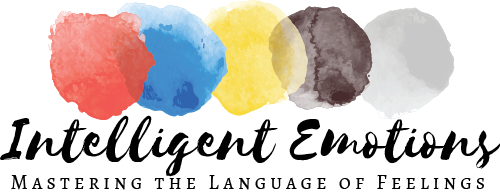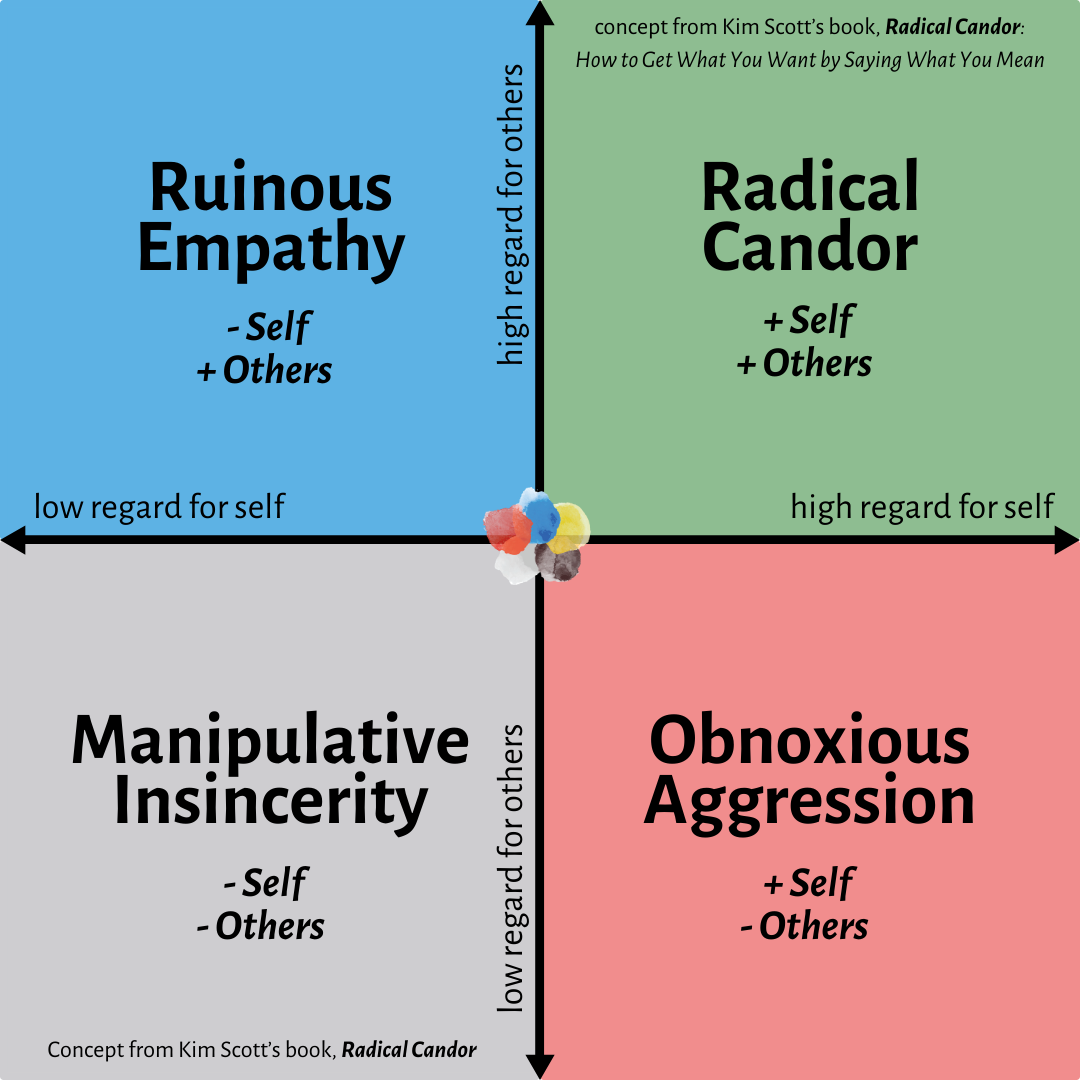Radical Candor: Balancing Regard for Self and Others
Do you feel like your needs don’t matter, despite how much you do for others? Learn how to move towards Radical Candor, a relationship stance that creates room in the relationship big enough for both yourself and others.
Healthy Relationships Start with RECIPROCITY
Connection with others varies from person to person. Sometimes you give more to the relationship, sometimes you might give less. Sometimes the relationship exists without much contribution from either party.
But the strongest relationships form when BOTH you and the other person make room for BOTH of your needs & wants. One person is not inherently more important than the other.
What makes this reciprocity possible? The ability to clearly and directly advocate for yourself while considering the well-being of both yourself and the other — what Kim Scott calls reaching “Radical Candor”.
In this emotional intelligence book, Scott outlines the four types of relationships defined by the balance or imbalance of self and others. I go into depth below how Radical Candor applies to our daily relationships, not just in the professional context that was her initial audience.
The Four Relationship Quadrants
Kim Scott illustrates the four relationship types in an XY grid (a so-called radical candor quadrant), where the X-axis represents care or regard for the self, and the Y-axis represents care or regard for others. Here are the four stances:
Obnoxious Aggression
Manipulative Insincerity
Ruinous Empathy
Radical Candor
When relationships have an imbalance of care for yourself or others, it can create relationships with conflict, resentment, shame, and inauthenticity. Learning which quadrants on the graph your relationships fall into can help you pinpoint areas to work on in order to achieve a balanced relationship that actively creates enough space for BOTH yourself and others.
Obnoxious Aggression
This relationship type falls into the bottom-right quadrant, reflecting a relationship with high regard for the self and little regard for others.
Characteristics:
Bully types or bossy.
Steamroll through relationships.
Don’t take feedback (e.g., disregard feedback or refuse to listen to feedback).
Unnecessarily aggressive (e.g., seem to look for challenges or accidentally challenge others often).
Rely on their power over others.
Tips for Reaching Radical Candor:
Learn how to consider others/increase care for others. (E.g., practice reflecting on how others may interpret your words and tone. Will saying X hurt their feelings?)
Directly ask for feedback and respond to it for course-correction. (E.g., invite others to give you feedback. “How could I have addressed this better?” Consciously listen and implement feedback.)
Understand others are different from you. (E.g., not everyone has the ability to know their own needs as well as you do. Give people the space to understand theirs and feel safe to ask for your support.)
Don’t expect others to act as you do. (E.g., a person may not be able to stand up for themselves as you can.)
Manipulative Insincerity
This quadrant lies in the bottom left of the graph, depicting a relationship with regard for neither the self or others.
Characteristics:
Gossipers.
Show up in certain circles but do something else entirely different behind the scenes. (E.g., fulfills work roles adequately on the surface and disrupts working relationships with gossip amongst co-workers.)
Very surprising or mysterious. (E.g., others usually can tell where these people stand and their insincerity is not a complete shock. You can probably think of a few people like this in your workplace or social circles right now.)
Hard to read.
Interacting with these people might tense up the body because they don’t know what to expect.
Have a plastered/plastic smile with no “evidence” of what they are doing wrong. (E.g., appear friendly but inauthentic, and it is unclear why they appear inauthentic because there is no evidence of it.)
Use power indirectly. (E.g., guilt-tripping, gossiping, making fun of others, challenging the character of others, dismissive, etc.)
Tips for Reaching Radical Candor:
Learn how to be direct with communication. (E.g., avoid using indirect means of power like guilt-tripping and dismissiveness.)
Learn how to state their own needs.
Honor and respect the other person. (People are different from each other, and each deserves respect.)
Give information directly to avoid confusion or self-doubt from other parties. (E.g., instead of guilt-tripping a roommate to help with chores, tell them you need help maintaining the house upkeep.)
Ruinous Empathy
This person falls into the top left quadrant, where a person gives too much emphasis to others and not enough to the self. Most of my clients fall into this quadrant.
Characteristics:
Have an allergic reaction to anger
Highly Sensitive Persons, Empaths, caregiver types
Overdo their empathy. (Empathy CAN be overdone and is not automatically a good thing.)
Empathy goes too far and leaves no room for the self.
On the surface, they are kind, serving, empathetic people, but this happens with an engine of shame behind the scenes. (E.g., shame may motivate a person to serve others because they feel like they are not enough.)
Overly extending self to others leads to burnout easily and creates a shame spiral. (E.g., “I should be able to do better,” self-judgment for “selfishness.”)
Can cultivate resentment when there is not enough time for oneself. (Resentment often shows up with guilt, and people may have a difficult time noticing and/or acknowledging this.)
Tips for Reaching Radical Candor:
Must learn how to care for themselves as much as others. (This will feel selfish at first because you’ve been trained to center on others, but it is NOT selfish, it’s SELF-CARING. In order to deeply care for others well, you must care for yourself; otherwise, acts are tainted with resentment, guilt, and shame.)
Practice anger. (Let yourself feel angry and hurt. Learn how here. These emotions are not selfish to have.)
Practice self-care and self-compassion. Start with these simple exercises.
Do things that at first trigger a sense of guilt and shame—this indicates you are going in the right direction. (E.g., be honest about your needs and explain to your loved ones when they do something that upsets you. This will trigger a sense of guilt/shame at first, but these are necessary steps for balancing your relationship and moving into radical candor.)
Radical Candor
This is the ideal place for a relationship. In the top-right quadrant, this represents an equal balance of worthiness between the self and others.
Characteristics:
Able to create balance where you know others matter just as much as you do, and you matter just as much as others.
Are able to speak up for their own needs.
Speaking the truth kindly but directly.
Intentionally addresses issues instead of skirting around problems.
Reaching Radical Candor
Moving into the quadrant of radical candor can be very difficult for some people. Being assertive about your own needs can be scary if you have trouble putting yourself out there or if you are scared of the negative reactions from others, but it is necessary work for strong relationships.
When you consciously and directly address issues in the relationship or clearly communicate your needs, you give the other person a chance to repair and address these issues and needs.
Waiting for others to fulfill needs and address issues that you skirt around or avoid speaking about lays the groundwork for an imbalanced relationship and resentment.
As you navigate your work and social life in the coming weeks, evaluate your relationships and see if you can identify which quadrant(s) you fall into. Is there a balance between yourself and others? From there, you can work towards achieving radical candor in your relationships.
Save this to Pinterest to return to it later
The BIG Feelings First Aid Kit
Messy feelings spilling out at the
WRONG TIME,
WRONG PLACE,
WRONG WAY?
Grab this free PDF guide to handle feelings like a pro so that you can keep moving forward in life!
Other Blogs on Relationships
© Copyright 2023 Joanne Kim. All rights reserved.
Joanne Kim, Feelings Translator
Hi! I’m a therapist-turned feelings coach who helps Highly Sensitive Persons, Empaths, Enneagram 2s & 4s, etc. turn their BIGGEST feelings into their GREATEST superpower!
They are often the first (or only) person in their family to intuitively process and express feelings; consequently, they are often judged or criticized so that they learn to people please, placate, or perform until they hit a wall.
They’re super familiar with anxiety, guilt, and shame, partly because of an allergic reaction to anger (theirs and others').
Often the super responsible, empathic, and ethical person in their environments, they reach out to me after they're already burned out, resentful in their relationships, or sucked into their shame spiral.
The most common feedback I get from people when I share about how feelings work is,
"Why didn't anyone teach me this in school??"
Hence, I am building a school helping people work WITH their feelings so their feelings work FOR them.














You may feel sometimes like you’re going in circles - expending so much energy, time, and resources to change, only to find yourself in the same place all over again. As more time goes on, you feel like the future is bleak - what’s the point of trying, if it’s going to be the same? Perhaps what’s the issue is not what’s happening but how you perceive what’s happening. What if you ARE actually changing?